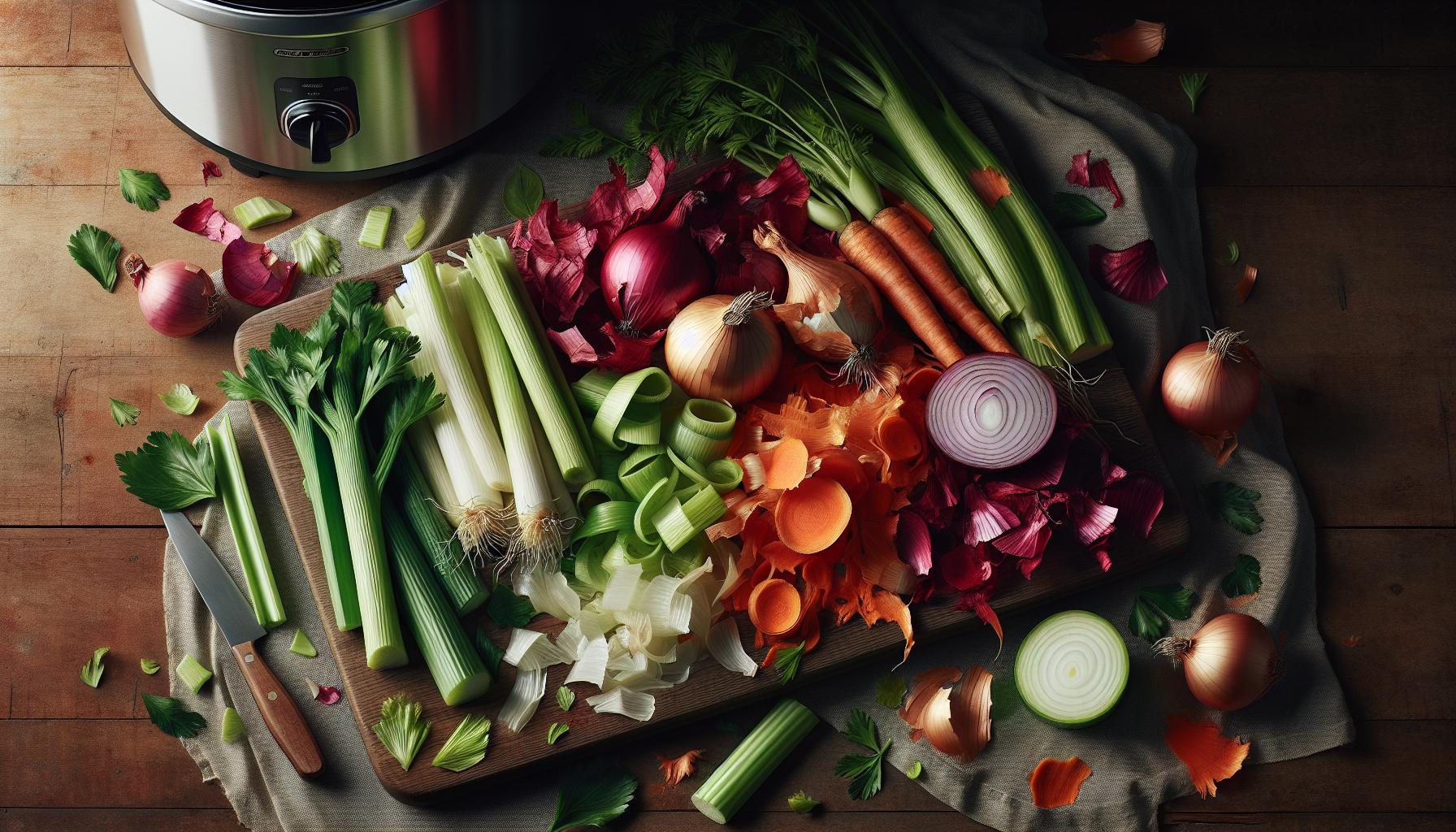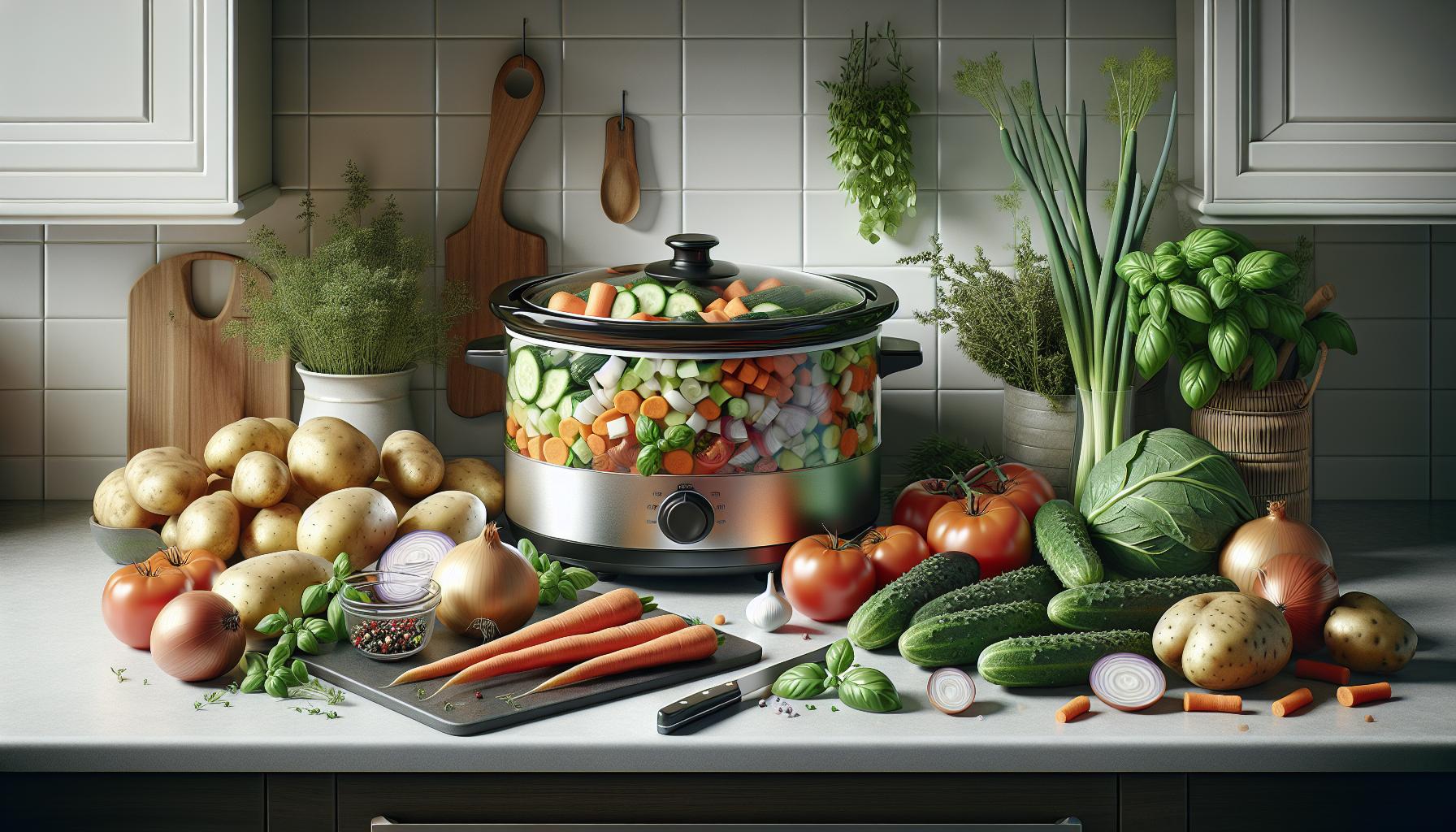Ever thought about turning your veggie scraps into something amazing? Well, you can! Making vegetable stock in a slow cooker is not only easy but it’s a smart way to reduce waste.
All those peels, ends, and leaves you usually toss can become a flavorful base for soups and stews. Plus, it’s a set-it-and-forget-it kind of deal. Just gather your scraps, add water, and let your slow cooker do its magic.
Benefits of Making Vegetable Stock from Scraps in a Slow Cooker
When you make vegetable stock using your slow cooker, you’re doing a huge favor for both your wallet and the planet. It’s a total win-win! You’ll cut down on food waste since you’re using scraps that you might’ve tossed out. Those onion skins, carrot peels, and celery ends? They’re gold for making a tasty stock.
Save Money while boosting flavor. You’ve already spent your hard-earned cash on veggies, so why not get the most out of them? Instead of buying stock from the store, use what you’ve got and make something that will up your cooking game.
Your slow cooker is the perfect tool for this no-fuss process. You can toss in your scraps, add water, set the timer, and forget about it for hours. Slow cookers use less energy than stovetops, which means you’re also being more energy-efficient.
Imagine coming home to the rich smell of homemade stock, with Deep Flavors that just can’t be copied by store-bought versions. Making your own means you’re in control. You decide what goes in. No extra salt, no preservatives – just pure, veggie goodness.
When you use a slow cooker, you break down the veggies slowly and gently. This means all the nutrients have time to seep into the water, making your stock packed with vitamins and minerals. So not only is it good for the environment and your pocket, but it’s also Good for Your Health.
In every steamy cup of stock made from veggie scraps, you’re sipping on minerals that can boost your immune system and keep you strong. Plus, making stock can be super relaxing. It’s a low-key kitchen activity that gives you a break from the fast-paced world.
Are you ready to get the most out of your veggies? Give it a try and taste the difference for yourself. And guess what? You can use this stock in so many ways! Soups, stews, sauces, and even cooking grains – they’ll all taste better with your homemade stock.
Go ahead, see what you can whip up with your veggie stock from scraps. And remember, every bit you save from the trash is a small step toward a healthier planet.
What Can You Use to Make Vegetable Stock?

In your quest to become a savvy kitchen eco-warrior, knowing what goes into your slow cooker for that perfect vegetable stock is key. The beauty of stock-making is its simplicity and flexibility. Eager to get started? Grab a large bowl and start saving those bits and bobs from your veggie prep.
Vegetable Scraps to Save
Almost any vegetable scraps can transform into a rich stock. Here’s a quick list:
- Onion skins and ends
- Carrot peels and tops
- Celery leaves and ends
- Potato peels
- Garlic skins and leftover pieces
- Mushroom stems
- Squash skins and seeds
- Bell pepper cores and seeds
- Zucchini ends
Remember cruciferous vegetables like broccoli or cauliflower can give your stock a bitter taste—better to leave them out. Also, avoid anything rotten or moldy; quality in equals quality out.
Herbs and Flavors
Upping the flavor game takes just a pinch of ingenuity:
- Bay leaves
- Sprigs of fresh herbs like thyme or parsley
- Whole peppercorns
- A dash of salt
Consider adding a splash of soy sauce or a strip of kombu (seaweed) for depth. But go easy—your stock should be a backdrop for other dishes.
Prep and Storage Tips
Rinse your scraps to remove any dirt before tossing them into your slow cooker. If you’re not ready to make stock yet, keep them in a freezer bag in the freezer. They’ll be fine there for months. When the bag’s full or you’re in the mood for a soothing kitchen project, you’re all set to go.
Making vegetable stock from scraps is like turning lead into gold in your kitchen. The slow cooker works its magic, creating a base for soups, stews, and sauces with flavors that store-bought stocks can’t match. As you learn to tweak the ingredients to suit your palate, you’ll see that your homemade stock is not just a frugal choice but a culinary stepping stone to more flavorful cooking.
Tips for Collecting Vegetable Scraps for Stock

Gathering vegetable scraps is the first step to making a rich and aromatic stock. You’ll want to start by setting up a designated container in your fridge. This can be a freezer bag or a storage bin with a lid. Make sure it’s big enough to hold a week’s worth of scraps but not so big it takes over your fridge space.
As you chop and prep your veggies for other dishes, keep an eye out for the parts you might usually toss. Here’s a quick list of what to save:
- Carrot peels and ends
- Celery leaves and stalk bases
- Onion skins and roots
- Leek greens and tough outer layers
- Parsley stems and other herb scraps
Remember, only save scraps that are clean and unspoiled. If it’s too far gone (like moldy or rotten), it won’t do your stock any favors.
When you add scraps to your container, press out as much air as you can before sealing it up if you’re using a freezer bag. This helps keep the scraps fresh. If your stock-making day isn’t soon, you can pop the container in the freezer to preserve the scraps even longer.
To keep things interesting, mix up the types of scraps you collect. A variety of veggies will give your stock a complex flavor. But watch out for bitter scraps, like cabbage cores or too many kale stems, as they can overpower your stock’s taste.
Once you’ve got a good amount of scraps, you’re ready to start cooking. Just transfer them to your slow cooker, fill it with water, and let it do its magic. Remember, a longer cooking time means a deeper flavor, so don’t be afraid to let it simmer.
How to Make Vegetable Stock in a Slow Cooker
Making vegetable stock in a slow cooker is easy and it’s a great way to use up those vegetable scraps you’ve been collecting. You’ll want to start by giving your slow cooker a quick check. Make sure it’s clean and ready to go before you begin.
First, gather all the vegetable scraps you’ve saved. You’ll need about 4 cups of scraps to make a rich and tasty stock. It’s okay if you have a bit more; this isn’t an exact science. Remember, variety is key to a complex flavor, but avoid adding too many bitter scraps like kale stems or Brussels sprout trimmings.
Next, fill your slow cooker with the scraps. Add water until the scraps are completely covered. You’ll want about 6 to 8 cups of water, depending on the size of your slow cooker. Then, go ahead and toss in a couple of bay leaves and a sprinkle of salt. These will add some depth to the stock’s flavor.
It’s time to let the slow cooker work its magic. Set it to low and let it simmer for 6 to 8 hours. Some folks like to let it go even longer, up to 12 hours, for a deeper taste. As it cooks, your kitchen will start to smell amazing.
Keep in mind that as it simmers, the scraps will break down and meld together, forming the base of your homemade stock. Halfway through, you might want to give it a stir to ensure everything’s cooking evenly.
After the time’s up, you need to strain the stock. Use a fine mesh sieve or cheesecloth to separate the liquid from the scraps. Be sure to press down on the scraps to squeeze out all those tasty juices. And there you have it – your very own homemade vegetable stock!
Now you’ve got a flavorful base for soups, stews, and sauces. Plus, you’ve cut down on waste by repurposing those veggie scraps. Each batch will be a little different, and that’s the beauty of making stock at home.
The Advantages of Using a Slow Cooker for Making Stock
When you’re ready to turn your vegetable scraps into delicious stock, using a slow cooker can make the process easier and more rewarding. Slow cookers maintain a consistent low temperature, which means the flavors from your scraps have time to meld together and create a deep, rich flavor that’s hard to achieve with quicker methods.
Here’s why a slow cooker could be your best friend in the kitchen:
- Hands-Off Cooking: Simply toss in your scraps, add water and seasonings, set the temperature, and let the slow cooker work its magic. You don’t have to watch over it, freeing you up to do other things.
- Energy Efficiency: Slow cookers use less electricity than stovetops or ovens, making them an eco-friendly choice for cooking.
- Flavor Development: The gentle heat helps extract flavors and nutrients from each scrap, ensuring nothing goes to waste.
Additionally, slow cookers excel in safety. You can leave your home without worrying about an open flame. This means you’re free to let your stock simmer for the full 6 to 8 hours, or longer if you’re after that extra richness in taste. It’s the kind of set-it-and-forget-it convenience that makes homemade stock simple.
Remember, the key to great stock is in the simmer. Unlike a rapid boil, which can make your stock cloudy and overly strong, a slow cooker keeps things clear and subtle. It’s perfect for achieving that golden hue and clear brothy texture that’s a hallmark of good vegetable stock.
Moreover, a slow cooker is superb for catching all the subtle notes from a variety of scraps. Sweet, earthy, or herby, each component gets a chance to shine. Your final stock will not only be a treat for the taste buds but a testament to the power of slow cooking.
So by now, you’ve got your clean slow cooker, your variety of veggie scraps, and water at the ready. It’s almost time to begin the transformation. Before that, let’s take a moment to understand the best scraps to use and those to avoid to ensure your stock embodies perfection.
Recipes and Ideas for Using Vegetable Stock
Once you’ve made your golden-hued, flavor-packed vegetable stock in the slow cooker, you’ll be looking for ways to use it up. The stock you’ve created is not just a base but a transformative ingredient that turns good dishes into great ones.
Soups and Stews are the most obvious choices for using your homemade vegetable stock. A simple yet classic vegetable soup comes to life with the deep flavors from your stock. Or, take things up a notch by crafting a hearty lentil stew, letting the lentils absorb the rich, complex flavors.
Rice Dishes like risotto will have a new depth of flavor when cooked with your vegetable stock. Swap out water for stock when making rice or quinoa and watch these grains go from plain to extraordinary.
For a quick and easy meal, try making Pasta Sauces. Simply reduce your vegetable stock, add some fresh herbs, and toss it with your favorite pasta. The stock will give a subtle, yet noticeable lift in taste.
You can even use vegetable stock to make Bread. Replace the liquid in your bread recipe with vegetable stock for a moist loaf with an unexpected flavor twist.
Don’t overlook the simplicity of Steamed Vegetables. Steam broccoli or cauliflower in vegetable stock instead of water to infuse them with flavor without overpowering them.
Remember, vegetable stock isn’t just for cooking. Marinades make use of its flavor too. Marinate tofu or tempeh in vegetable stock before cooking to give it a savory taste.
And don’t forget the Gravies and Sauces. A flour and butter roux mixed with your vegetable stock will create a delicious gravy, perfect for drizzling over mashed potatoes or vegetarian meatloaf.
Make sure to keep your vegetable stock at the ready for adding a flavor boost to a variety of recipes. Your kitchen creativity is the limit when it comes to using your homemade stock.
Conclusion
You’ve now got the know-how to transform your vegetable scraps into a rich, homemade stock with the help of your slow cooker. It’s a simple, sustainable practice that elevates the flavors in your cooking while reducing waste. Remember, the key to a great stock lies in the variety of scraps you use, so keep experimenting. With your new batch of golden, flavor-packed stock, you’re ready to enhance all your favorite dishes. So go ahead, give your meals that extra depth of flavor they’ve been missing, and enjoy the satisfaction that comes with making the most out of every ingredient in your kitchen.





